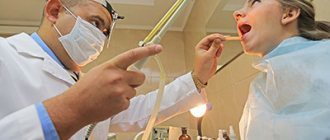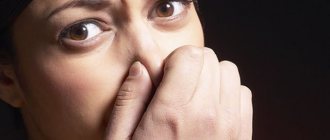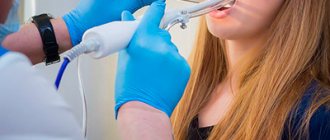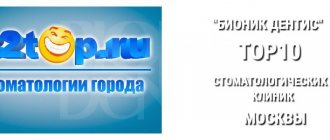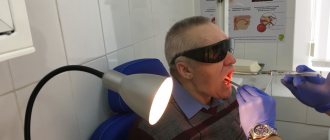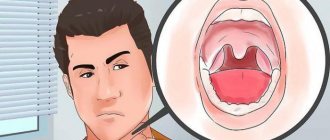Washing methods
This procedure must be carried out carefully, it is better to have it done by a specialist, since with the wrong approach you can aggravate the situation up to the development of sepsis, driving the inflammatory process even deeper or damaging soft tissues.
Washing of the lacunae of the tonsils is carried out in the following ways:
- Using a syringe for intralaryngeal infusions and rinsing of the tonsils.
- Vacuum rinsing of tonsils with the Tonsilor apparatus.
- Deep rinsing using phonophoresis and ultrasound.
Who's at risk
The following are primarily susceptible to the disease:
- Children are carriers of pathogenic microflora. As soon as favorable conditions for the disease occur (for example, during hypothermia), the bacteria are activated. An inflammatory process occurs. The main causative agent of sore throat is considered to be β-hemolytic streptococcus of group A or B.
- Malnourished children. An unbalanced diet, lack of essential vitamins in the diet, and, as a consequence, low body weight - all this inevitably leads to a weakening of the children's immune system.
- Children with congenital or acquired immunodeficiency conditions, when the body is not able to produce the required number of immune cells to fight viruses.
- Children experiencing frequent hypothermia. Low temperatures are always stressful for the body, especially for children. In such tense conditions, he cannot work fully. As a result, the smallest amount of bacteria becomes enough to cause disease.
- Children with existing chronic diseases of the oro- and nasopharynx: caries, stomatitis, sinusitis, etc.
- Children with allergies
Flushing with a syringe
This method can be offered in any clinic. It is considered painless and lasts about 10 minutes. The patient is seated and asked to open his mouth. A cannula is attached to the syringe. The surface of the pharynx is treated with a solution of local anesthetic. They do this to reduce discomfort during manipulation.
After this, the cannula of the syringe is inserted into the cavities of the tonsils and their contents are sucked out. This can be pus, microorganisms and their metabolic products, food debris, or liquid. After the procedure, the surface is irrigated with anti-inflammatory solutions.
Why then wash the tonsils?
Usually the reason for washing is the so-called “plugs” or tonsillitis. Among patients and, unfortunately, often among doctors, there is a belief that these “traffic jams” are manifestations of a chronic infection. Sometimes you can hear the term “purulent plugs”. This description is incorrect. Indeed, in the lacunae (pores) of the palatine tonsils, food debris, calcium salts, dead and obsolete cells of the palatine tonsils and bacteria that normally live in the oral cavity sometimes accumulate. Together they form a white conglomerate, usually dense. Tonsilloliths themselves are not a sign of any disease. In the event that they physically interfere with the patient, as a rule, proper independent care of the oral cavity and teeth is sufficient.
Vacuum rinsing of tonsils
Modern otolaryngological offices carry out rinsing of the tonsils with Tonsilor - a special device that carries out cleaning using ultrasound and antiseptic solutions.
It quickly helps to achieve the desired result and has the following effect after use:
- anesthetic;
- antibacterial and antifungal;
- increases local immunity;
- restores normal microflora on the surface of the tonsils.
Symptoms
Rheumatism of the joints, inflammation of the myocardium, endocardium can be a consequence of chronic tonsillitis! Strictly follow the instructions of the otorhinolaryngologist!
- Frequent sore throats.
- Local symptoms: sore throat, discomfort, sore throat, etc.
- Bad breath.
- Reflex coughing attacks caused by irritation of the mucous membrane of the palate and larynx.
- Enlarged cervical lymph nodes (this symptom is typical for children and adolescents, but can occur in adults).
- Low-grade fever.
- Headache, weakness, weakness.
- Changes in the heart.
Contraindications to washing with hardware methods
Despite such a positive effect from hardware methods, in some cases this method cannot be used. These include:
- Retinal detachment.
- Hypertension in stage 3 or 2B.
- 1st and third trimester of pregnancy.
- Acute forms of infectious diseases.
- Oncopathology.
- Atherosclerosis of coronary or cerebral vessels.
- Active tuberculosis.
- Disorders of the autonomic nervous system.
- Pathology of the respiratory and cardiovascular systems in the stage of decompensation.
When is tonsil flushing contraindicated?
The procedure is not recommended for people with arterial hypertension - there is a risk of a sharp increase in blood pressure. Also among the contraindications:
- acute infectious diseases of the gums, teeth and throat;
- increased body temperature;
- retinal pathologies and glaucoma;
- severe heart failure;
- 1st and 3rd trimesters of pregnancy;
- allergy to solutions used for rinsing.
Do not use faulty appliances. An irrigator can damage your gums and tonsils if the jet pressure is too strong. If the device does not work well, replace it.
Washing tonsils at home
If you have tonsillitis, you can rinse your tonsils at home. Someone close to you can help you with this, or do everything yourself. To begin, prepare a saline or furatsilin solution and thick cotton swabs. Soak the latter well with the resulting liquid and then wash the affected lacunae with light pressure. Repeat the action several times.
Those who know the exact location of the organ can manipulate it using a syringe. The needle is then removed. To use this method, you need to have certain skills.
Special vacuum attachment
It turns out that no matter what method you choose, the likelihood of injury to the tonsils is high? For many years now we have been using a special modified vacuum attachment - a joint brainchild of the head of the clinic V.M. Zaitsev and his colleagues-otolaryngologists. This is our development, our own “know-how”, which has no analogues in any other ENT clinic. The advantages of this attachment, compared to the usual TONSILLOR attachment, are obvious:
- the pressure created by it is sufficient to carry out flushing as efficiently as possible and release purulent plugs from lacunae
- The nozzle cup has rounded edges. This helps avoid injury upon contact with the surface of the tonsil.
- The walls of the cup are transparent: the ENT doctor can clearly see what is being washed out of the gaps and when the manipulation can be stopped. The patient does not have to undergo unnecessary procedures.
- the nozzle is more elegant, smaller in size and much more convenient. With its help, you can effectively and painlessly wash lacunae even for children.
Frequently asked questions related to the procedure
- How many treatments are needed? To get rid of tonsillitis you need to undergo 5-10 procedures. The specific number is determined by the doctor depending on the extent of the inflammatory process.
- Is pain relief provided? Although irrigation is carried out without a needle, local anesthesia is still used. They do this to reduce discomfort during manipulation.
- How to prepare for the procedure? Preparation consists of refusing to eat at least an hour before the upcoming wash.
- How often should you rinse your tonsils? The need for the procedure depends on the activity of the disease and the rate of accumulation of fluid, food particles, and bacteria in the lacunae. Only the attending physician can determine the frequency of washing. At least once a day.
- How long should I rinse my tonsils? Even if during a single procedure it was possible to completely remove the contents of the lacunae, the manipulation will have to be repeated at least 7-10 more times, it is better to do it every day. This is due to the constant proliferation of pathogenic microflora. And this approach will allow you to achieve stable remission.
- Are there any special features of oral hygiene during the course of treatment? During the course of treatment after each procedure, it is prohibited to eat for the first two hours. It is also worth giving up solid food during this period, since after eating it, a piece may get stuck in the passages.
Thus, washing the tonsils for tonsillitis is an effective treatment method. But if carried out incorrectly, a serious complication can develop, so it is better to contact a specialist.
What is the reason for this difference in approaches in the practice of Russian doctors and their colleagues from other countries?
First of all, the criteria on the basis of which the diagnosis of chronic tonsillitis is made are very different. In Russian medical practice, this diagnosis is often made based on an examination of the throat, even without assessing the patient’s history. In the practice of doctors from European countries, Japan, and the USA, such a diagnosis is rarely made, and based on a number of signs.
Patients who have been diagnosed with this can often hear about a “locus of chronic infection”, the risk of developing other diseases due to the fact that dangerous bacteria spread from the palatine tonsils to other organs and systems. Today this medical concept is outdated. Numerous studies and meta-studies have shown that only one disease has a risk of spreading beyond the tonsils - tonsillitis or, in scientific terms, “streptococcal acute tonsillitis”.
Sore throat is a disease caused by certain bacteria that are easily transmitted from person to person. If a patient suffers from tonsillitis more than 2-3 times a year for several years, the tonsils need to be removed. This is the only measure that, from the standpoint of modern science, can help the patient in this situation and negate the risks of developing other diseases.
Rinsing the tonsils does not reduce the risk of developing tonsillitis.
Advantages of treatment at an ENT center
Treatment of ear, nose and throat diseases at the ENT CENTER is a comprehensive and individual approach to each patient. By making a preliminary appointment on the medical center’s website or by phone, you can:
- get face-to-face consultation with a specialist;
- undergo treatment of ENT diseases using progressive techniques;
- receive recommendations for further conservative treatment and prevention of ENT diseases.
Contact the ENT CENTER : here they will help you solve any problem within the competence of ENT doctors as efficiently, safely, quickly and painlessly as possible.
What is the Tonsillor device?
"Tonsillor - 3MM" is used for the conservative and surgical treatment of diseases of the ENT organs through the combined effects of ultrasound, vacuum and ozone/NO-containing medicinal substances on the affected tissues.
Ultrasound, which has healing properties, allows for anti-inflammatory and resorption therapy, pain relief, improves blood microcirculation at the site of exposure, cleans wounds of necrotic tissue and bacterial contamination and creates a drug depot at the site of the lesion. Under the influence of ultrasound, trophism, blood supply to tissues, metabolism improve, and local immunity is stimulated.
Causes
The etiology and pathogenesis of chronic tonsillitis has not been fully studied to date.
The starting mechanism in the development of chronic tonsillitis is repeated inflammatory processes leading to local immunosuppression.
- Local causes are infectious foci (carious teeth, purulent sinusitis, etc.).
- Pathogenic and opportunistic microorganisms.
- Immunodeficiency states.
- Persistent violation of nasal breathing (adenoids in children, deviated nasal septum, etc.).
- Allergic sensitization of the body.
Classification
| Simple form Characteristic: the course of the disease with local symptoms, subjective complaints and objective signs of the disease, with frequent sore throats, and in other cases - without repeated sore throats (“anginless” chronic tonsillitis). | Toxicallergic form Characterized by: low-grade fever, phenomena of tonsillogenic intoxication, manifestations of tonsillocardiac syndrome. |
Diagnostics
THE INSTITUTE OF ALLERGOLOGY AND CLINICAL IMMUNOLOGY has a fundamental base that allows it to carry out the full range of diagnostic and therapeutic measures for any form of allergy that meets the level of international standards. Many of the diagnostic and treatment methods were developed by the staff of our Institute.
Diagnostic measures are based on anamnesis, clinical picture and laboratory diagnostics.
- Bacteriological examination of mucus from the tonsils and posterior pharyngeal wall for aerobic and facultative anaerobic microorganisms.
- Determination of the sensitivity of microorganisms to antibiotics and other drugs.
- Detailed general (clinical) blood test, clinical urine test.
- Determination of the concentration of C-reactive protein in blood serum.
- Determination of antistreptolysin-O in blood serum.

